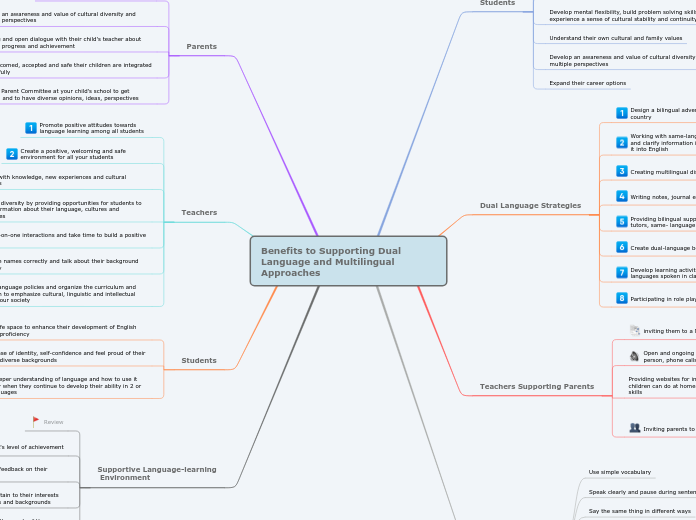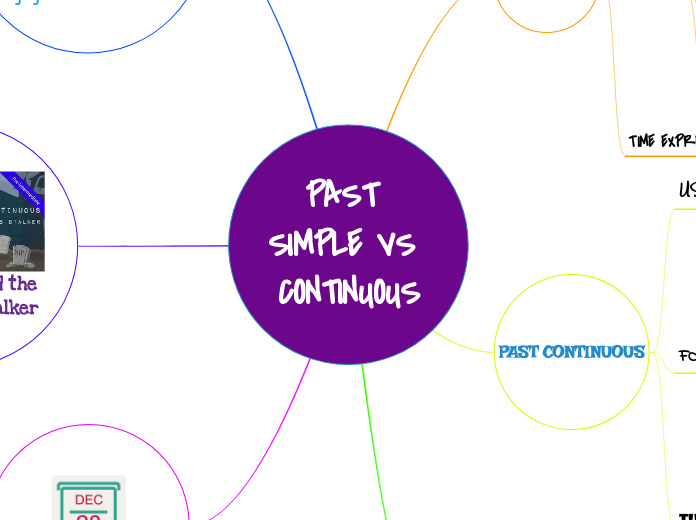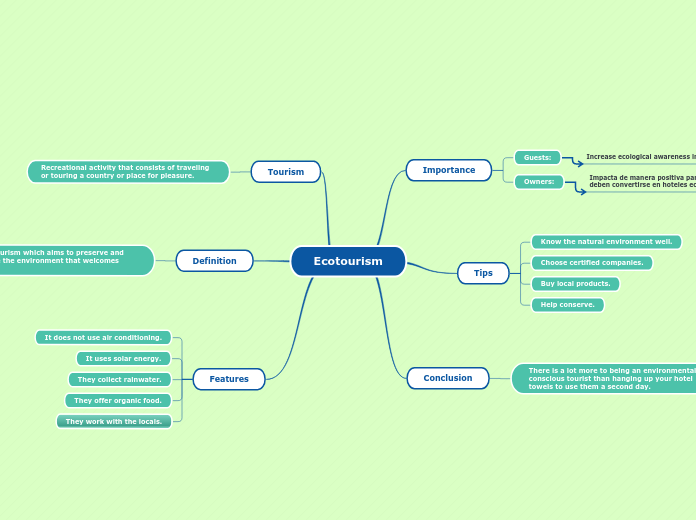Benefits to Supporting Dual Language and Multilingual Approaches
Use this mind map to plan and easily organize your lessons.
Supportive Language-learning
Environment
Space is flexible and adaptable to meet the needs of the students
Engage all students in activities that pertain to their interests and build on their prior knowledge, skills and backgrounds
In order to ensure the continuity of future assessments, create a quick overview of the student knowledge you were able to evaluate and write down some key points regarding their performance.
Give English language learners positive feedback on their efforts
Outline all the information you will need in order to create your evaluation content, add notes and figure out what type of assessment will conclude your lesson (test, essay, presentation, etc).
Tasks are appropriate to the student's level of achievement
After having graded and analyzed your students' work, establish what kind of feedback you will give them.
Will you have a discussion or will you give them written indications on the tests?
Will students need to review some of the content they didn't fully understand?
Review
Try to evaluate your planned assessment and establish whether it's appropriate as evidence for the Student Learning Objective.
Homework improves student achievement and teaches students to work independently.
Provide your students with feedback on their homework, as this is an essential instrument allowing you to enhance the significance of assignments in their overall academic life.
Gain a deeper understanding of language and how to use it effectively when they continue to develop their ability in 2 or more languages
Builds sense of identity, self-confidence and feel proud of their culturally diverse backgrounds
Have a safe space to enhance their development of English language proficiency
Teachers
An actual experience with discussions will help students grasp the connections between different topics. Students will have the chance to use their knowledge gathered in class or during the personal researches and be able to participate effectively in the discussion as group members.
Develop language policies and organize the curriculum and instruction to emphasize cultural, linguistic and intellectual capital of our society
Pronounce names correctly and talk about their background and family
Have one-on-one interactions and take time to build a positive rapport
Celebrate diversity by providing opportunities for students to share information about their language, cultures and experiences
Enriched with knowledge, new experiences and cultural awareness
Create a positive, welcoming and safe environment for all your students
Promote positive attitudes towards language learning among all students
Parents
More and more teachers are using visual aids and other helping tools to exemplify lessons.
Join the Parent Committee at your child's school to get involved and to have diverse opinions, ideas, perspectives
Feel welcomed, accepted and safe their children are integrated successfully
You can attach your own previously created mind maps or you can ask them to create their own.
Ongoing and open dialogue with their child's teacher about learning progress and achievement
You can recommend books to your students which are related to your lesson, or which will help them gain a broader perspective on the lesson.
Related videos or documentaries, audio books.
Preserve family ties, cultural background
Write down what materials you want to use.
Effective Practices
Give students more time to process questions and responses
Modify tasks
Check in with students on their level of understanding and progress
Use visuals (images, objects), gestures and body language to display information
Say the same thing in different ways
Speak clearly and pause during sentences
Use simple vocabulary
Teachers Supporting Parents
Inviting parents to the classroom and engaging in activities
Guest speaker to read a dual language book, share about their culture, traditions, child-parent activities
Keep your students engaged with group games, allowing them to practice vocabulary, grammar rules, learn new concepts, etc.
Watching role plays, puppet shows, presentations
Think about group exercises that will engage your students’ critical thinking techniques, while also promoting teamwork.
Providing websites for information and suggesting activities children can do at home to continue to practice their English skills
Plan and create the handouts your students will receive in order to support the day’s activities.
Open and ongoing dialogue about students progress (in person, phone calls, emails, communication book)
Help your students learn and practice the conversational techniques needed to move the discussion forward, with the discussion cards.
inviting them to a Meet and Greet
Add your printable worksheets meant to reinforce your students’ comprehension.
These could contain different types of exercises and even provide a quick overview of the day’s lesson.
Dual Language Strategies
Establish your goals.
What do you want your students to achieve?
Participating in role plays, puppet shows, movies (visual)
Develop learning activities that take advantage of the first languages spoken in class (compare letters, numbers, objects)
Create dual-language books, display/read dual language books
Providing bilingual support: Room partners, cross-grade tutors, same- language partners for think, pair, share activities
Writing notes, journal entries in your dominant language
Creating multilingual displays or signs
Working with same-language partners who discuss a problem and clarify information in the first language before translating it into English
Design a bilingual advertisement to attract visitors to a country
Students
Expand their career options
Develop an awareness and value of cultural diversity and multiple perspectives
Understand their own cultural and family values
Develop mental flexibility, build problem solving skills, experience a sense of cultural stability and continuity
They can preserve family ties, cultural backgrounds and sense of their identity
Here you should type in the timeframe of this class.
Develop proficiency in their first language while learning English helps them academically and socially because knowledge about concepts and language skills are transferrable
Starting date of the class.
Known experiences provides reassurance, in which students are more accessible to acquire new skills and concepts
Type in the title of your class.









